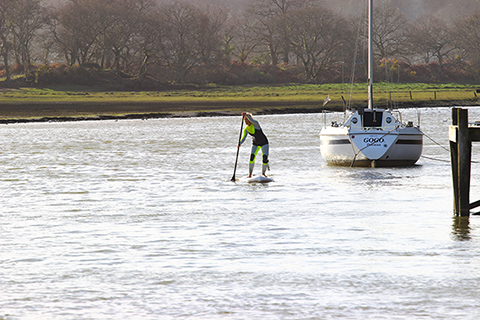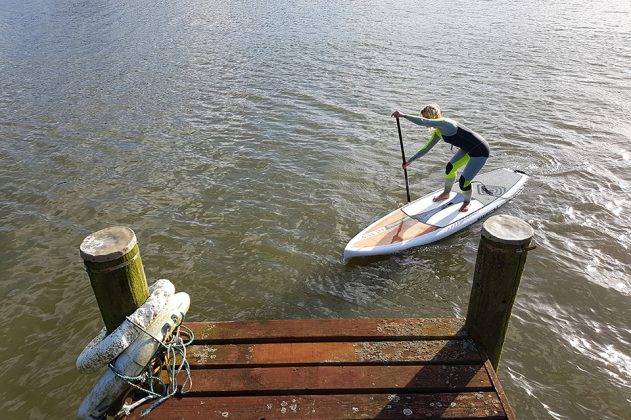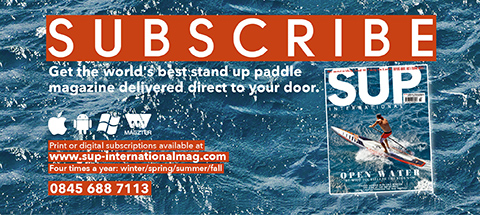PADDLE SCIENCE #7 –
TRAIN SMARTER, NOT HARDER
Words – Kate Starling
In this feature, we’re going to talk about bringing a bit of science into your paddling sessions this year. It’s easy to do, and especially for those of us returning to the water after a semi-hibernation, it will not only help you reach your last peak of physical fitness, but totally eclipse it. This method will help keep you injury free, avoid staleness in your sessions, and make you look like you’re carved from wood.
Sure, you may well have hit the gym and cross trained for a few months to stay fit but your SUP fitness is likely to have reduced. It’s worth then thinking about how to retrain for SUP so that you can optimise your performance this coming year when you’re out on the water. This is of particular importance if you’re aiming for any goals such as building your endurance to paddle 20km, building your speed for a forthcoming race or simply because you’d like to get as fit as you can for SUP over the next twelve months.
PERIODISATION
If you’re keen to start training and training well, periodisation is the means by which you can attain peak performance by following a well-structured training plan. This plan breaks your training down into smaller, manageable phases and helps to ensure that within each phase you focus on and meet specific training objectives. Periodisation aims to maximise the effects of training, adjust for the effects of fatigue and prevent possible overtraining. Within a periodisation plan, training volume and intensity is fundamental. Volume is defined as the amount of work performed in a training session or training block. Meanwhile, intensity is defined as the percentage of your maximum effort. This can include variables such as time, distance and resistance. If you’ve only ever SUP-ed the same distance at the same pace or never change your SUP routine then over time your SUP workouts will fail to deliver any fitness improvements. This is because doing the same thing over and over again will fail to challenge your nervous system. Varying and changing what you do on your SUP board is therefore paramount to increase your muscle strength, endurance and power.
Changing the volume, intensity or frequency of your workouts will pay dividends for your fitness and this is exactly where periodisation comes in. Both volume and intensity need to be periodically increased and decreased to achieve improvement. Periodisation is applied on a cyclical or periodic basis, structured into macro-, meso- or microcyles. Typically, but not always, a macrocycle refers to a year, a mesocycle to a month and a microcycle to a week. One example is to work on your strength and endurance for four weeks and then switch to building power for the next four weeks, interspersed with a week in which you rest and recover.
RECOVERY AND ADAPTATION
Periodisation consists of stressing and overloading your body in a particular way and then allowing your body to rest recover and adapt. Following this, the cycle is repeated and your body is subjected to stress again. It is this continued cycle of stress versus rest which allows for optimal improvement in both your fitness and overall performance level. Mesocycles are typically arranged into a 3:1 loading paradigm. In other words, over the first three weeks loading should gradually increase before an unloading phase in the fourth week. Or you could for example, have a 4:2 paradigm. Notably, the greater the number of loading weeks the greater the number of unloading weeks is required. Unloading is critical as it helps to prevent fatigue, maximise adaptation and essentially gives your body time to recover. Without it adaptation and the ability to overcome fatigue will be compromised, boosting the likelihood of injury and overtraining. Importantly, your rest period should involve active rest rather than sitting doing nothing. Therefore, aim to do low intensity activities outside of your normal training schedule such as pilates or swimming in your rest week. This can help to recharge you both mentally and physically.
TRAINING PHASES
Four phases exist within a periodisation programme. Within each phase, the specific volume, intensity and frequency of your SUP sessions will vary according to your age, physical fitness, experience and ultimately your SUP goals.
“Developing a good and efficient paddle stroke early on is important so that your technique is honed by the time you progress to higher intensity paddling ”
(1) PREPARATION PHASE
In this phase, the objective is to build your aerobic base or endurance. Training should yield aerobic improvements together with adaptations in your cardiovascular blood vessels, increased ventilation and increased fat burning. At the start of this phase you should feel entirely rested after an easy winter, with the aim of introducing yourself to some slow, steady paddle sessions. Whether you’re new to SUP or an experienced paddler, building up your fitness slowly is important by performing low-intensity, short duration paddle sessions before gradually increasing your training volume by increasing the time spent paddling. Consider at this stage focussing on your paddle technique so that any bad habits or poor form can be addressed. Developing a good and efficient paddle stroke at this stage is important so that your technique is honed by the time you progress to higher intensity paddling.
A useful tool is to use video feedback or get an experienced paddler to watch you so that they can give you constructive tips on your paddle technique.
Typically, the base level phase should be 8-20 weeks in duration and consist of the following:
• A good warm up and cool down each session
• Aerobic conditioning. During this phase your heart rate shouldn’t exceed 75% of its maximum
• Improving cardiovascular and basic muscular strength
• Cross training, for example running or cycling can be incorporated to boost cardiovascular endurance at a low intensity
• Paddling volume rather than intensity. Your SUP sessions should be longer low to medium intensity workouts rather than shorter and high intensity
• Each week, increase your training volume. However, aim to increase your training volume by no more than 60% from week to week
• Begin with a 45 minute paddle with easy effort and build up gradually to 90 minutes
• Ensure that you recover and have active rest every third to fourth week
• Perfect your paddling technique
• Outside of your board time, start to gently build muscular strength with light weights and a high number of repetitions (12-20)
• SUP is an all body workout. Therefore off the water, perform functional compound movements such as pull-ups, push-ups and squats to maximise your cross training potential

(2) GENERAL PREPARATION PHASE
This phase generally consists of 12-16 weeks and focuses on three primary objectives: the development of strength, power and aerobic endurance or stamina. It also incorporates a degree of anaerobic training. This can help to optimise the overall fitness you require in order to demonstrate peak performance in your SUP race or endurance paddle mission. Physiologically, this stage will help to increase carbon dioxide removal, respiratory muscle work and removal of waste products from your muscles. Having built a base level of fitness in the first phase, now you should aim to increase volume and intensity via specific interval training sessions.
Throughout phase two aim to focus on:
• Aerobic conditioning with up to two anaerobic training sessions each week. Following a warm up, aim to SUP interval train in bursts of 15-30 minute efforts at 80-85% of your maximum heart rate. Any interval effort should be performed at your anaerobic threshold.
• Gradually increase the volume and intensity of your SUP workouts from week to week
• Continue active rest and recovery every third or fourth week
• Develop your strength and power. When doing weights, increase the weight and lower your number of repetitions (8-12)
• Maintain your flexibility
• Address any niggles or aches and pains that might be hindering you together with fatigue
(3) SPECIFIC PREPARATION PHASE
Typically this phase lasts for 2-4 months and aims to develop your physical capacity specifically for SUP. It therefore focuses on technique as well as strength. During this phase, your primary aim will be to increase your training intensity together with maintaining or slightly increasing your training volume. If you have a race coming up, practice SUP-ing in race conditions and focus on perfecting your skills and technique that you’ll require come race day. This can include for example beach starts and turning. If you have an endurance event, practice paddling in choppy water or going downwind together with pacing. At this point your level of fitness should be high. Increase your strength and aim to increase the intensity of your SUP sessions through interval training.
Interval training sessions should be shorter in length but should work you to 95% of your maximum heart beat. Also continue to develop your power and consider incorporating a little cross training to maintain your aerobic capacity whilst giving your muscles time to recover from your interval training workouts. As the intensity increases during this phase, pay even more attention to your body. Make sure that you get adequate rest and focus on treating and overcoming any injuries.
(4) COMPETITION PHASE: EVENT OR END GOAL
The fourth and final stage of your periodisation training plan, are the last few weeks before your race, event or achievement of your personal goal. This phase can be split into smaller phases known as tapering and peaking. You should aim in this phase to increase your training intensity whilst maintaining or slightly reducing your training volume. Balance is critical. Therefore, don’t aim to perform two high intensity workouts on two consecutive days. Link in rest days and ensure that you limit your training volume to distances that are no greater than 60% of the endurance or race event that you’re training for. At this point, 90% of your activity should take place on your SUP board.
Tapering
In the week or two prior to your race or event, tapering should take place. This means that you need to greatly reduce your training volume and incorporate short, high intensity interval training sessions instead. The level of volume and intensity in this stage will vary according to the event you’re training for. However, to promote your chances of achieving your goal it’s critical to reduce your level of training significantly.
Peaking
Ideally, peaking is the stage at which you should be in the best physical condition for your event. It’s really important to recognise that in the last one to two weeks before an event, any training will not result in significant fitness gains. Therefore, just before your race for example, don’t be tempted to jump on your board and paddle twenty miles. At this point, when your event is just two days away, aim to either not paddle at all and completely rest or do just a very short, gentle paddle only.
(5) TRANSITION PHASE
Having trained smart for the past year, this last phase, the transition phase is the time in which you should allow your body to fully recover from training. Hang your wetsuit up, put your board in the garage and focus on doing something entirely different such as swimming, running or a new sport. This phase should be used to facilitate mental rest, relaxation and physical recovery and should typically last for about 3-4 weeks. At the end of it you should feel rested and up for a brand new SUP challenge. SUP
Kate is a physiotherapist and standup paddler. Reach her at www.newquayphysio.co.uk


